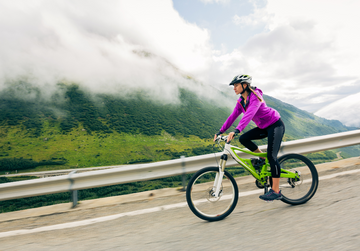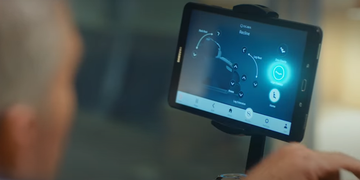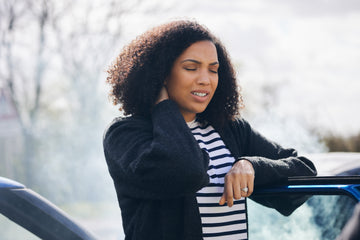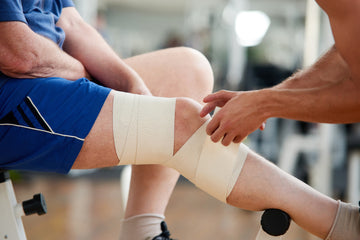Nearly a million people in the United States commute to work each day by bicycle, with the number of cyclists for pleasure and sport reaching the tens of millions. With so many individuals choosing to ride, it comes as no surprise that knee pain from cycling is the number one injury that occurs.
We’re examining what causes cycling knee pain, the major types, and the symptoms these injuries may cause. Learn about a few treatment options to alleviate knee pain after cycling and get back on your bike in no time.
Common Causes of Cycling Knee Pain
Cycling knee pain is the overuse or strain of muscles, tendons, and ligaments around the knee joint. Regardless of whether you’re a professional athlete, cycling to work, or riding for recreation, knee pain from cycling can be uncomfortable or even debilitating.
Some of the most common causes of cycling knee pain are:
- Poor bike fit: A bike that is too big or too small, or one that is not adjusted properly, can cause knee pain after cycling. It’s crucial to have the proper equipment adjusted to your body.
- Muscle strain: Cycling long distances or at high intensity without proper rest and recovery can lead to overuse injuries like tendonitis or bursitis. It’s an example of a type of repetitive motion injury that can keep you off your bike for days or even weeks for recovery.
- Muscle imbalances: Weakness or imbalance in the muscles surrounding the knee can lead to cycling knee pain and injury.
- Falls or accidents: A sudden impact or fall while cycling can cause knee injuries like sprains or fractures.
As with any type of vehicle, bicycles should be used properly at all times. Misuse can lead not only to knee cycling pain but a variety of other more serious repercussions like serious accidents with lasting damage.
Symptoms of Knee Pain From Cycling
The symptoms of knee pain from cycling can vary depending on the type of injury or condition. When you’re using a bicycle, be sure to stretch appropriately before and after, as well as be mindful of how your body feels during your ride. If you experience symptoms of cycling knee pain, consult your doctor for an assessment and to determine a plan for recovery.
A few common symptoms to look out for include:
- Pain around the kneecap or on the sides of the knee
- Swelling and stiffness in the knee joint
- A grinding or popping sensation in the knee
- Difficulty bending or straightening the knee
- Pain that worsens during or after cycling
Different Types of Cycling Knee Pain
Cycling knee pain can occur in different parts of the knee. This is dependent on which areas are experiencing excess stress during your ride. They are the anterior, posterior, lateral, and medial parts of the knee.
- Anterior (front) knee pain: Cycling knee pain felt in the front or center part of the patella. This is the most common knee pain cycling injury. This type of knee pain from cycling is often patellofemoral pain (PFP) caused by irritation of the cartilage beneath the kneecap.
- Posterior (back) knee pain: The least common knee pain cycling injury area. Posterior knee pain most often indicates that the muscles and tendons of the hamstrings are overworked. These injuries may happen when the leg is overextended (especially if the bike saddle is too high) or due to a trauma such as a car accident.
- Later (side) knee pain: Another uncommon knee pain cycling injury, lateral knee pain is most often the result of a collision with the side of the knee while riding. When this happens, the knee is pushed outward, resulting in damage to the lateral collateral ligament. While it’s an uncommon knee pain from cycling, it is a common sports injury for soccer players.
- Medial (middle) knee pain: These types of knee pain after cycling most often are an indicator of underlying causes or a direct result of a collision with the outside of the knee pushing it inward. Underlying causes could include inflammation such as bursitis.
Treatment Options for Knee Pain After Cycling
While it’s important to consult your doctor if you’re experiencing cycling knee pain, there are many options for treatment for you to try. Each body responds differently, so you may find a combination of different treatment methods for knee pain after cycling work best for you.
Some popular options are:
- Using the R.I.C.E. method: This method is an acronym for the steps involved: rest, ice, compression, and elevation.
- Getting a massage: A massage may be helpful to gently work out overused muscles and help recover more quickly.
- Foam rollers: These recovery tools provide basic targeted treatment to areas affected by cycling knee pain.
- Doing gentle stretches: Stretches and exercises to keep muscles loose, especially in the legs and thighs, are beneficial for alleviating knee pain after cycling. Be sure to stretch before cycling, as well, in order to warm up the muscles before use.
- Wearing a knee brace: A knee brace or other compression garment may help expedite your cycling knee pain recovery. It pairs well with the R.I.C.E. method.
- Heat therapy: The benefits of heat therapy have been shown to enhance the healing process, reduce inflammation, and help with recovering from sports injuries.
Those experiencing cycling knee pain may not be up for traveling to a massage appointment or could be unable to get an appointment when they need it, which is why so many cyclists have turned to the benefits of massage therapy at home using a luxury massage chair. Today’s massage chairs have evolved to provide just as effective a massage as a traditional massage therapist. You have access to different types of massage programs at the touch of a button and can adjust the intensity to meet your needs.
Bonus massage chair features like heat therapy and zero gravity reclining combine multiple treatment options for cycling knee pain, making them the ideal tool for recovery. There are even AI massage chairs that use two types of body scanning to provide a massage experience tailored to your needs every time you use it. Sit back and relax knowing you’ve got a relief method right in the comfort of your own home.
Bonus: Massage chairs do more than just help with cycling knee pain. Learn how they are the perfect solutions for cycling back pain, as well.
How to Prevent Cycling Knee Pain
Just as it’s important to know how to alleviate cycling knee pain, it’s just as important to learn ways to prevent it from occurring in the first place. The best offense is a good defense. Taking steps to prevent knee pain after cycling will keep your body in top condition and help you avoid discomfort.
A few suggestions to prevent cycling knee pain include:
- Proper bike fit: Make sure your bike and all equipment pieces are adjusted properly to avoid putting unnecessary stress on your knees. To avoid knee pain from cycling, it’s most important to ensure the saddle is adjusted to the right height.
- Build up gradually: Gradually increase your mileage and intensity to avoid overuse injuries. Even if you’re already an athlete, working these muscles is new to you and you’ll need to increase your stamina to avoid injury.
- Low-impact exercises: Incorporate other low-impact activities like swimming or yoga into your regular routine in order to help strengthen the muscles around the knee. These activities will help prevent cycling knee pain but may also be used for recovery.
- Self-care: Regular self-care activities like exercise, getting a massage, and even meditation can help your body stay in optimal condition and avoid injury.
Cycling knee pain can range from mild discomfort to knocking you off your feet entirely. Whether you’re a recreational cyclist, do it for sport, or ride to work each day, knowing what causes knee pain from cycling and how to treat it is vital. Take care of your body and keep on riding.
Curious about massage chairs and how they could pair with your lifestyle? Compare massage chair models and learn which one is right for you.





